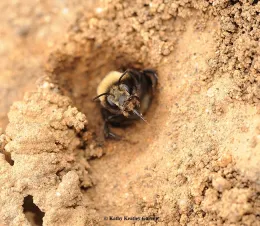
About 75% of all flowering plants rely on animal pollinators. Most pollinators (about 200,000 species) are beneficial insects such as honey bees, native bees, butterflies, moths, flies and beetles. As the saying goes, if you build it, they will come. So what are some ways in which gardens can be made more attractive for the pollinators of all kinds?
First, know the pollinators. Everyone knows the European honey bee, which was imported 400 years ago and brought to California around 1850. But did you know there are over 4,000 species of native bees in the United States, of which 1600 are found in California?

Approximately 70% of native bees are solitary ground nesters, while 30% are cavity nesters. As well as providing pollinator-friendly plants to your yard, help ground nesting bees make their homes in your garden, by leaving a sunny area mulch-free. For cavity nesting bees, provide artificial nest sites, which are easy to construct or purchase from commercial outlets.
Hummingbirds, with their long beaks and tongues draw nectar from tubular flowers. Pollen is carried on both the beaks and feathers. To attract these fun loving birds to your garden, be sure to include bright colored tubular flowers in your landscape.
Butterflies are eye-catching, as are the flowers that attract them. Not only are specific flowers important, but also providing open areas such as bare earth and large stones where butterflies may bask and moist soil from which they may get needed minerals. To support butterflies, a gardener may also be willing to accept slight damage to host plants that provide food for the larval stage of the butterfly.

Moths are mostly evening fliers attracted to flowers that are strongly sweet smelling, open in late afternoon or night, and are typically white or pale in color. Moths are easy to differentiate from butterflies if you look at their antennae; moths do not have a swelling at the end of their antennae whereas butterflies do.
Bats are nocturnal pollinators that play an important role in the pollination of agaves and cacti in the Southwest, however not necessarily in our specific region. Bats are usually found visiting light-colored flowers that open at night and often produce copious amounts of pollen and nectar.
Flies are not typically thought of as pollinators, however, many masquerade as bees in the garden. Syrphid flies, also called hover flies, are considered to be very important pollinators in agriculture.

Over 30,000 species of beetles are found in the United States, they may not be efficient pollinators but they do play a role as they visit flowers to sip nectar or feed on the flower parts. This activity may result in pollination. Some have a bad reputation because they damaging plants.
If you haven't seen it yet, please watch our YouTube video, Native Pollinators, to learn about different kinds of bees you may find in your garden.
National Pollinator Week is a campaign by the Pollinator Partnership.
Helpful Resources
How to Attract and Maintain Pollinators in Your Garden. Free ANR Publication

Build Bee Houses. Free publication from Michigan State University.
US Forest Service: Pollinators
Heidi Aufdermaur is a graduate of the 2019 Class of Master Gardeners in Stanislaus County.

